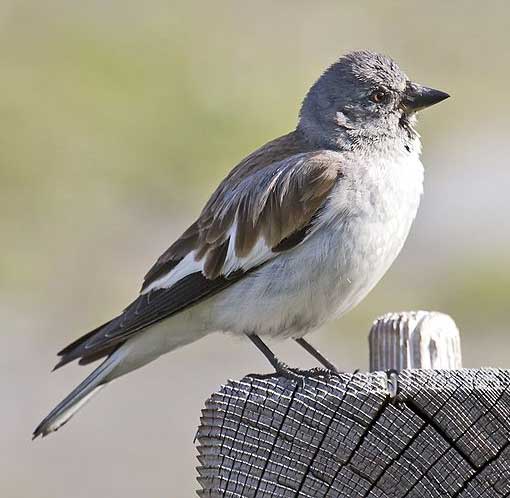Montifringilla nivalis (Andreas Trepte, www.photo-natur.de) Cladus: Eukaryota Name Montifringilla nivalis (Linnaeus, 1766) Vernacular names Reference Syst. Nat. ed.12 p.321 The White-winged Snowfinch, or just Snowfinch (Montifringilla nivalis) is a small passerine bird. Despite its name, it is a sparrow rather than a true finch. It is a resident breeding species on bare mountains, typically above 1,500 metres (4,900 ft), across southern Europe and through central Asia to western China. It nests in crevices or rodent burrows, laying 3–4 eggs. White-winged Snowfinch is a large stocky sparrow at 16.5–19 centimetres (6.5–7.5 in) in length. It has brown upperparts, white underparts and a grey head. There is a long narrow white wing panel. In summer, the bill is black, and there is a black bib. The bib is lost in winter and the bill becomes yellow. Sexes are similar. In flight, it shows black wings with huge white wing panels, and a white edged black tail. This bird has a chattering song with many trills, and variety of rolling or creaky calls. White-winged Snowfinch’s food is mainly seeds with some insects. It is fearless, and will forage around ski resorts. It is hardy, and rarely descends below 1,000 metres (3,300 ft) even in hard winter weather. There are four subspecies. The darkest, M. n. henrici of Tibet and western China has earth-brown upperparts and crown, and greyer underparts. It is sometimes split as the Tibetan Snowfinch (Montifringilla henrici). However, Tibetan Snowfinch, confusingly, more often refers to the Black-winged Snowfinch (Montifringilla adamsi). References ^ BirdLife International (2004). "Montifringilla nivalis". IUCN Red List of Threatened Species. Version 2006. International Union for Conservation of Nature. Retrieved 12 May 2006. Lei, F.-M.; Wang, A.-Z.; Wang, G.; Yin, Z.-H. (2005). "Vocalization of red-necked snow finch, Pyrgilauda ruficollis on the Tibetan Plateau, China – a syllable taxonomic signal?". Folia Zoologica 54 (1–2): 135–146. Source: Wikipedia. Wikispecies: All text is available under the terms of the GNU Free Documentation License |
|

